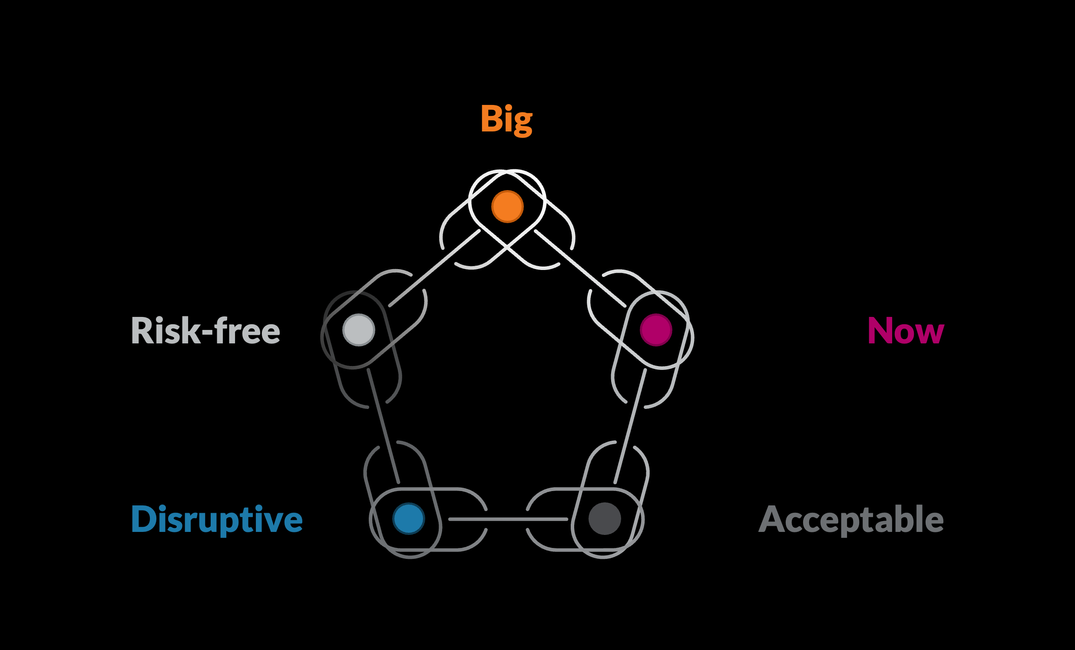TL; DR
You may find it frustrating when stakeholders demand outcomes that don't all seem possible to pull off together.
If you share those goals with them upfront, they may still want them all. But maybe you can build empathy for how hard it is to achieve. If you're really lucky, your leaders may even be willing to tell you which of these goals (not all) are the hard priority at any point in time.
Only some of these outcomes are mutually exclusive(-seeming). Only pairs of them are. But they all tie into each other, making them tricky in total.
What is this even about?
It would be nice if we can "have it all." But that's not real. Humans notoriously want more than is reasonable.
In the world of project management, the "Iron Triangle" (or project management triangle or triple constraint) emerged to visualize the problem.
The essence of the Iron Triangle from project management:
Bosses want work to be all of (1) cheap, (2) fast, and (3) good/ making lots of progress.
But in reality, they can only have no more than 2 out of 3.
When good leaders talk with their project managers, they understand this and use the tool to provide good guidance on what the true priorities are and what might give if needed. E.g., it might be that in some project, budget and due dates are set, but progress made can adapt to what's possible with that time and money.
My friend David Dabscheck (thank you David!) realized that Innovation faces similar hard constraints and challenged me to develop a version of the Iron Triangle for our work.
Here's a first attempt. You may have feedback to make it better. If so, please share. But it feels "good enough to start."
How did the Innovation Pentagon come about?
To see if such a thing might exist, I had to go back to the core question that led to the Iron Triangle and assess how the same logic might apply in our world.
The Iron Triangle answers two basic questions:
- What are the things that bosses inherently demand?
- How do those things relate to each other? Can you have them all at the same time? If not, how do they trade off?
E.g.: In the case of the original iron triangle:
- Bosses want fast, cheap, and good/ progress.
- They can have no more than two at a time. But any two are possible.
What are these impossible-to-combine goals in Innovation?
- I've so far found 5 things bosses want (that I couldn't cluster and collapse further). They want things:
- Big
- Now
- Acceptable
- Disruptive
- Risk-free
- I like these 5 because they make an elegant set in terms of their relationships to each other. Specifically: after some futzing, it seemed to stand out that these five form pairs of natural opposites that come around in a circle, well pentagon I suppose:
- Big ... AND now
- Now ... AND acceptable
- Acceptable ... AND disruptive
- Disruptive ... AND risk-free
- Risk-free ... AND big
How to use it
Essentially, you can have one of each pair (unless the team manages to break the constraints 😄).
- Lay the groundwork: This is important! Before your project starts, share this framework with your key leaders. Let them know that even if it seems theoretical right now, the day will come when they will ask you for something possible. And then you will remind them of this conversation and will ask them to make tradeoffs among these outcomes, even if they don't want to.
- Be ready: Keep the framework handy.
- Gently remind your leader: When your leaders do inevitably ask for multiple mutually-exclusive things, pull this out and remind them of it.
- Trade off: Ask them to pick (no more than) one item from each pair. They will inevitably refuse. When they do, remind them that refusing to make tradeoffs simply means that the team will make the tradeoffs themselves, as best as they know how. but the leader won't be able to set any kind of guidance.
- Break constraints: So as not to be a jerk, try to come up with creative ways to break these tradeoffs and achieve supposedly impossibly combinations after all. Bonus points if you involve the leader who made the demand in your brainstorming.


